How many states of matter are there? When you were young, you probably learned about the three that are most common to our experience: solid, liquid, and gas. All of these occur with regularity here on Earth’s surface: rocks and ices are solids, water and many oils are liquids, while the atmosphere that we breathe is a gas. These three common states of matter are all based on neutral atoms, however; restrictions that the Universe is not bound by.
If you bombard any atom with enough energy, you’ll kick the electrons off of it, creating an ionized plasma: the fourth state of matter. Turn up the energy high enough, and even protons and neutrons will disintegrate, forming a quark-gluon plasma: arguably the fifth state of matter.
But there are two additional states of matter that not only can exist, but do: Bose-Einstein Condensates and Fermionic Condensates, the sixth and seventh states of matter. At present, they’re only achievable under extreme laboratory conditions, but they might play an important role in the Universe itself. Here’s why.
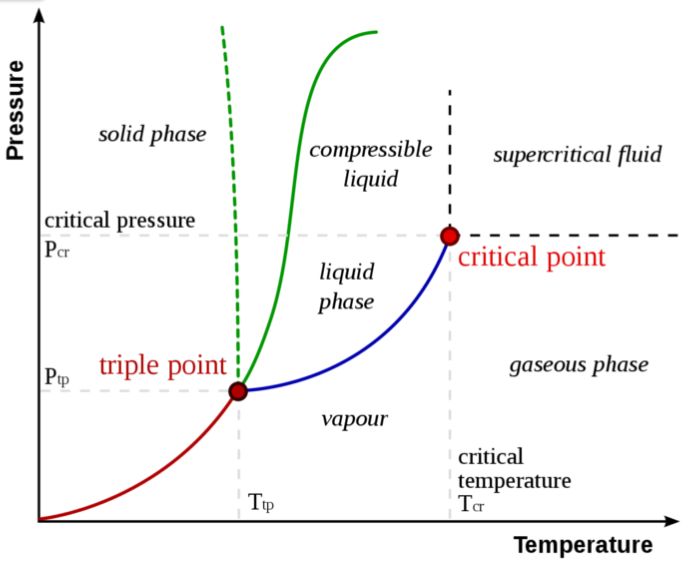
In the liquid phase, dropping the pressure significantly can result in a solid (ice) or a gas (water vapor), depending on what the temperature is and how rapidly the transition occurs. At sufficiently high temperatures, all atom-based matter will become an ionized plasma: the fourth state of matter. (Credit: Matthieumarechal/Wikimedia Commons)
Here on Earth, everything is made up of atoms. Some atoms bind together to form molecules; other atoms exist as standalone entities. Regardless of the number of atoms in any particular chemical compound — water, oxygen, methane, helium, etc. — the combination of temperature and pressure conditions determines whether it’s a solid, liquid, or gas.
Water, most famously, freezes at low temperatures and modest pressures, becomes liquid at either higher pressures and/or higher temperatures, and becomes a gas at still higher temperatures or very low pressures. There’s a critical temperature, however, above about 374 °C (705 °F), at which this distinction breaks down. At low pressures, you still get a gas; at higher pressures, you get a supercritical fluid with properties of both gas and liquid. Go to higher temperatures still, and you’ll begin ionizing your molecules, creating a plasma: that fourth state of matter.

When a grape is cut nearly perfectly in half, but a thin bridge of grape skin is left connecting them, a trip into the microwave will cause sparks to fly, creating a plasma along the bridge. Plasmas are created whenever electrons are kicked off of the atoms and molecules they were previously bound to, and at high enough energies and temperatures, all solids, liquids, and gases will become plasmas. (Credit: New York Times video)
Although that’s where most discussions of states of matter end, that’s hardly the end of the scientific story. In truth, that’s just the end of the atomic part of the story. For the rest, we need to venture into the subatomic world: the world of particles smaller than the atom. We’ve already met one of them: the electron, which is one of the fundamental particles of the Standard Model.
Electrons are the negatively charged particles in atoms that orbit the atomic nucleus, the same particles that get kicked off at high energies to form an ionized plasma. The atomic nucleus, meanwhile, is made up of protons and neutrons, which in turn are made of three quarks apiece. Inside protons and neutrons, gluons, as well as quark-antiquark pairs, are constantly created, destroyed, emitted and absorbed within each of these composite particles. It’s a messy subatomic world inside every proton and neutron.
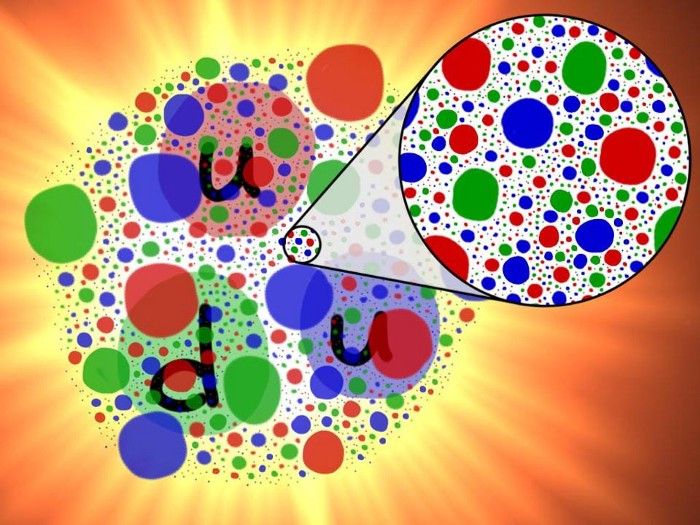
A proton isn’t just three quarks and gluons, but a sea of dense particles and antiparticles inside. The more precisely we look at a proton and the greater the energies that we perform deep inelastic scattering experiments at, the more substructure we find inside the proton itself. There appears to be no limit to the density of particles inside, but at high enough energies, protons and neutrons disintegrate to form a quark-gluon plasma: its own high-energy state of matter. (Credit: Jim Pivarski/Fermilab/CMS Collaboration)
If you increase the temperatures and energies to high enough values, even the protons and neutrons themselves will dissociate into the component quarks, gluons, and whatever quark-antiquark pairs you can create from the available energy and Einstein’s mass-energy equivalence law, E = mc². Whereas in our conventional experience, quarks always bind together three-at-a-time into bound states generally known as baryons, at high enough energies, they become a quark-gluon plasma: the fifth state of matter.
For approximately the first microsecond of the Universe after the start of the hot Big Bang, there were no protons and neutrons, but rather only a quark-gluon plasma, tightly coupled to all the other forms of matter, antimatter, and radiation that existed back then. We presently study these quark-gluon plasmas experimentally by colliding heavy ions — the bare atomic nuclei of atoms that contain large numbers of protons and neutrons, like gold, lead, and other atoms at the far end of the periodic table — in the world’s most powerful particle colliders.
Brookhaven’s RHIC (the relativistic heavy ion collider) and CERN’s LHC (the large hadron collider) have helped us not only explore the subatomic worlds of these particles, but how they behave as an aggregate: a full-fledged quark-gluon plasma.
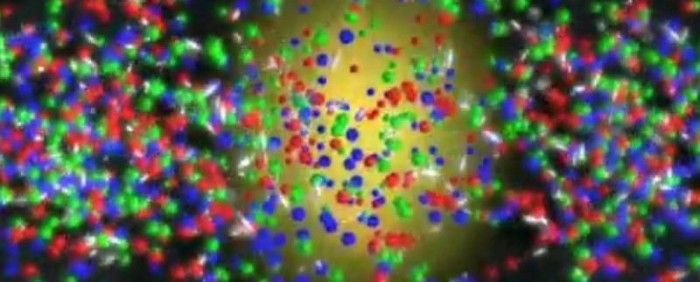
A collision between relativistic ions will sometimes, if the temperatures/energies of the particles are high enough, create a temporary state known as a quark-gluon plasma: where even individual protons and neutrons cannot stably formed. This is the nuclear analogue of a more standard plasma, where electrons and nuclei do not successfully bind together to form stable, neutral atoms. (Credit: Brookhaven National Labs/RHIC)
But even though these states of matter require very large numbers of particles, they also require very high energies to achieve. If, instead of going to high energies, we go to specialized conditions in the other, low-energy direction, we find that these particles can achieve something else remarkable: the creation of a sixth and seventh states of matter. There’s one key realization that’s required to lead us there: every particle in the Universe, no matter whether it’s a fundamental or a composite particle, falls into one of two categories.
- Fermion. This is a particle that, when we measure its spin (or intrinsic angular momentum), we always get values that are quantized in half-integer values of Planck’s constant: ±1/2, ±3/2, ±5/2, etc.
- Boson. This is a particle that, when we measure its spin, we always get values that are quantized in integer values of Planck’s constant: 0, ±1, ±2, etc.
That’s it. In all the known Universe, there are no particles — fundamental or composite — that fall into any other category. Everything that we’ve ever measured behaves either as a fermion or a boson.
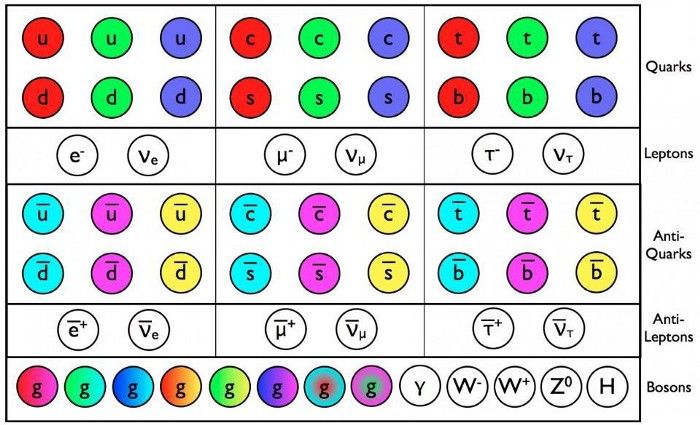
The particles and antiparticles of the Standard Model obey all sorts of conservation laws, but there are fundamental differences between fermionic particles and antiparticles and bosonic ones. (Credit: E. Siegel/Beyond the Galaxy)
Electrons, being fundamental particles with spins of ±½, are obviously fermions. Protons and neutrons, each of which are made up of three quarks apiece, also have spins that can only be ±½, as the spin of one quark will always oppose the spin of the other two. However, if you bind a proton and a neutron together, you create a composite particle known as a deuteron: the atomic nucleus of a heavy isotope of hydrogen known as deuterium.
A deuteron, which is a fermion bound together with another fermion, always behaves as a boson. (Why? Because ±½ + ±½ can only equal -1, 0, or +1: the spin values for a boson.) Whether we’re dealing with fundamental or composite particles, fermions and bosons exhibit a key difference from one another. Yes, their spins are different, but that difference leads to an amazing consequence: fermions obey the Pauli Exclusion Principle; bosons do not.
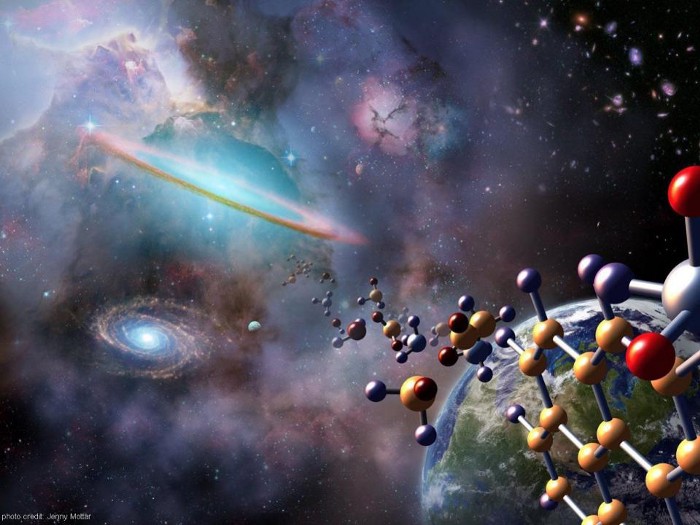
The way that atoms link up to form molecules, including organic molecules and biological processes, is only possible because of the Pauli exclusion rule that governs electrons, forbidding any two of them from occupying the same quantum state. (Credit: NASA/Jenny Mottar)
The Pauli Exclusion Principle is one of the key cornerstones that was discovered in the early days of quantum mechanics. It states that no two fermions can occupy the exact same quantum state as one another.
This comes into play when we start putting electrons onto a fully ionized atomic nucleus. The first electron will sink down to the lowest-energy configuration possible: the ground state. If you add a second electron, it will also try to get down to the ground state, but will find that it’s already occupied. To minimize the energy of its configuration, it drops into the same state, but needs to have its spin reversed: +½ if the first electron was -½; -½ if the first was +½. Any further electrons need to go into a progressively higher and higher energy state; no two electrons can have the same exact quantum configuration in the same physical system.
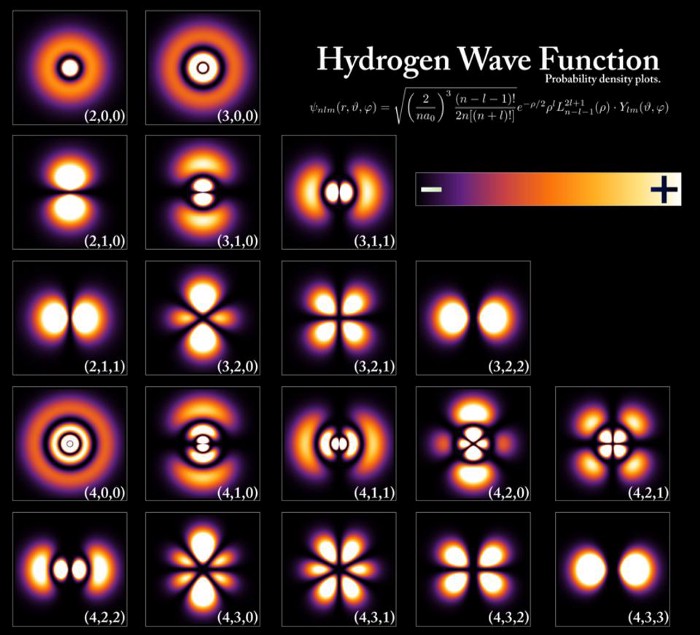
The energy levels and electron wavefunctions that correspond to different states within a hydrogen atom. Because of the spin = 1/2 nature of the electron, only two (+1/2 and -1/2 states) electrons can be in any given state at once. (Credit: PoorLeno/Wikimedia Commons)
But this is not true for bosons. You can place as many bosons in the ground-state configuration as you like, with no restrictions. If you create the right physical conditions — such as cooling a system of bosons and confining them to the same physical location — there is no limit to the number of bosons that you can fit into that lowest-energy state. When you reach this configuration, of many bosons all in the same, lowest-energy quantum state, you’ve achieved the sixth state of matter: a Bose-Einstein condensate.
Helium, an atom made of two protons, two neutrons, and two electrons, is a stable atom made of an even number of fermions, and therefore behaves as a boson. At low enough temperatures, it becomes a superfluid: a fluid with zero viscosity and no friction between itself or any container that it interacts with. These properties are a consequence of Bose-Einstein condensation. While helium was the first boson to achieve this sixth state of matter, it has since been reproduced for gases, molecules, quasi-particles and even photons. It remains an active area of research today.
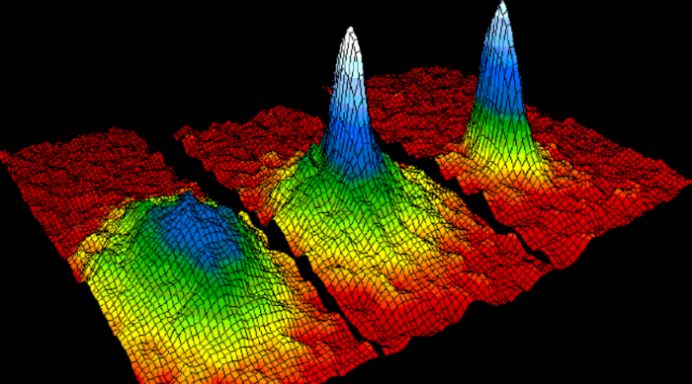
A Bose-Einstein condensate of rubidium atoms before (L), during (middle) and after (R) the transition to a BEC state is complete. The graphic shows three-dimensional successive snap shots in time in which the atoms condensed from less dense red, yellow and green areas into very dense blue to white areas. (Credit: ESA/University of Florence)
Fermions, on the other hand, cannot all be in the same quantum state. White dwarf stars and neutron stars don’t collapse because of the Pauli Exclusion Principle; electrons in adjacent atoms (in white dwarfs) or neutrons that border one another (in neutron stars) cannot fully collapse under their own gravity, because of the quantum pressure provided by the Pauli Exclusion Principle. The same principle that’s responsible for atomic structure keeps these dense configurations of matter from collapsing down to black holes; two fermions cannot occupy the same quantum state.
So how, then, can you achieve the seventh state of matter: a Fermionic condensate? Believe it or not, the story of Fermionic condensates goes all the way back to the 1950s, with an incredible discovery by the Nobel-winning physicist Leon Cooper. The term you’ll want to remember is named after him: Cooper pairs.
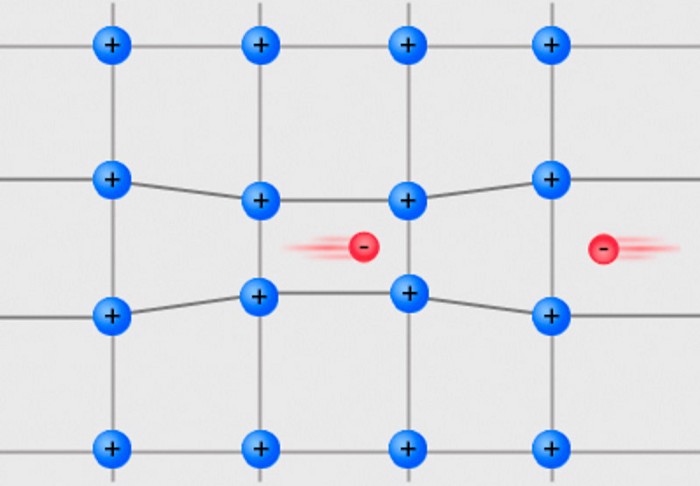
In a very low temperature conductor, negatively charged electrons will slightly change the configurations of the positive charges in the conductor, causing electrons to experience a slightly attractive relative force. This leads to the effect of them pairing up to form Cooper pairs, the first form of a fermionic condensate ever discovered. (Credit: Tem5psu/Wikimedia Commons)
At low temperatures, every particle tends towards its lowest-energy, ground-state configuration. If you take a conducting metal and lower the temperature sufficiently, two electrons of opposite spins will pair together; this tiny attraction will cause electrons to pair up as a less energetic, more stable configuration than to have all your electrons moving individually.
Fermionic condensates require lower temperatures than Bose-Einstein condensates do, but they also behave as a superfluid. In 1971, helium-3 (with one fewer neutron than standard helium) was shown to become a superfluid at temperatures below 2.5 millikelvin, the first demonstration of a superfluid involving only fermions. In 2003, physicist Deborah Jin’s laboratory created the first atomic-based Fermionic condensate, leveraging a strong magnetic field along with ultra-cold temperatures to coax the atoms into this sought-after state.
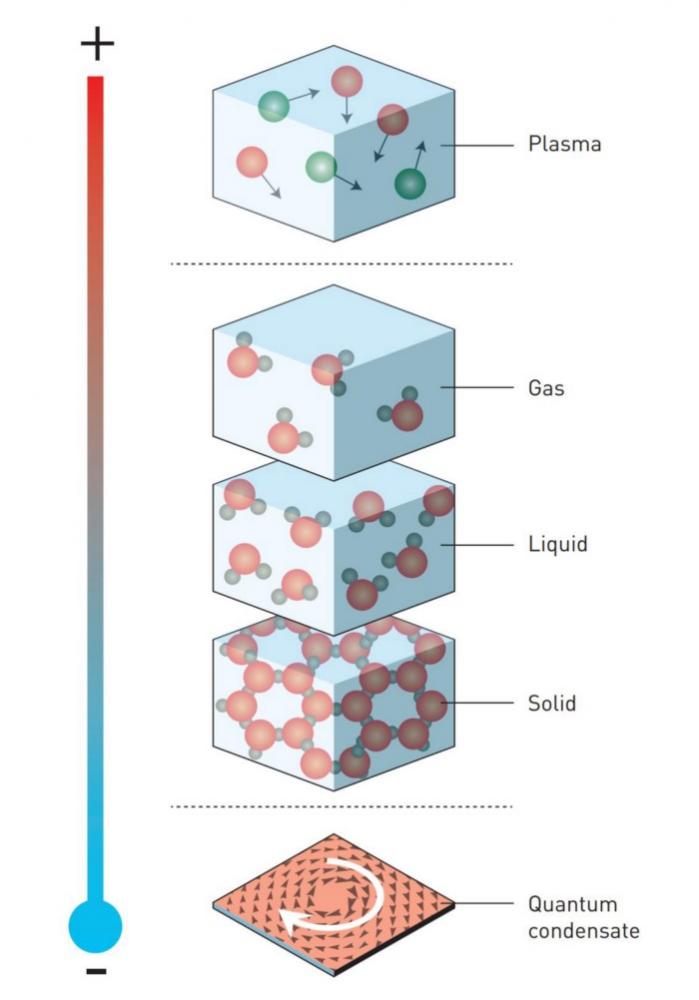
While solids, liquids and gases may be the most common states of matter, at extremely low temperatures, condensates can emerge, with unique physical properties. (Credit: Johan Jarnestad/The Royal Swedish Academy of Sciences)
In addition to the three standard states of matter — solid, liquid, and gas — there are higher-energy states of an ionized plasma, arising wherever atoms and molecules have too few electrons to be electrically neutral, and then of a quark-gluon plasma, where even protons and neutrons are broken up into their fundamental subatomic constituents. However, at ultra-low temperatures, the two fundamental classes of particles, bosons and fermions, can each condense together in their own particular fashion, creating Bose-Einstein or Fermionic condensates, respectively: the sixth and seventh states of matter.
In order to create a Fermionic condensate out of matter, however, you have to achieve extraordinary conditions: temperatures below 50 nanokelvin with an applied time-varying magnetic field. However, in the vast abyss of space, it’s eminently possible that neutrinos (made of fermions) or dark matter (which could be fermions or bosons) clump together to form their own condensates. The key to solving one of the greatest mysteries of the Universe — the dark matter puzzle — might lie in the rarest and most extreme of all the known states of matter.
Ethan R. Siegel is an American theoretical astrophysicist and science writer.
Ethan has lived his life fascinated with one simple fact: we have the capacity to figure out definitive, scientific answers to even the deepest questions we can conceive about our physical reality. We do that by asking the right questions about the Universe, and then putting the Universe itself to the test. From where everything comes from to the Universe’s ultimate fate and all that lies between, he’s committed to not just figuring it out, but to sharing the answers — what we know and how we know it — with anyone curious enough to listen.
A theoretical astrophysicist by training, Ethan left a promising research career in cosmology and a job as a physics and astronomy professor to focus on science communication full-time. He revels in telling scientifically accurate, beautifully illustrated stories about the Universe with the widest audience possible. He believes this Universe is the one thing we all have in common, and knowing our shared cosmic story should be for absolutely everyone, regardless of age, gender, race, religion, nationality, sexuality, educational and economic background, or any other trait.
Through stories told in a variety of formats — articles, books, podcasts, videos, interactive discussions, as well as in-person talks — he’s committed to ensuring that the best scientific knowledge we have about the Universe is available to all. You’re invited to join us on the journey.
Medium. Stay curious. Discover stories, thinking, and expertise from writers on any topic.
We’re creating a new model for digital publishing. One that supports nuance, complexity, and vital storytelling without giving in to the incentives of advertising. It’s an environment that’s open to everyone but promotes substance and authenticity. And it’s where deeper connections forged between readers and writers can lead to discovery and growth. Together with millions of collaborators, we’re building a trusted and vibrant ecosystem fueled by important ideas and the people who think about them.


Spread the word